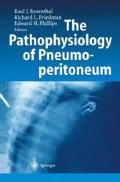Abstract
A pneumoperitoneum may result from the purposeful introduction of gas into the peritoneal cavity during laparoscopy. Any transgression of the abdominal wall, however, may permit gas to enter the peritoneal cavity. Such is the case during laparotomy. Similarly, abdominal wall trauma or female genital insufflation may produce a pneumoperitoneum. Pathologically, a pneumoperitoneum may be noted following perforation of the intraperitoneal gastrointestinal tract. Bronchopulmonary air leaks may track subdiaphragmatically and produce a pneumoperitoneum. Occasionally, pneumoperitoneum is the result of gas-producing organisms.
Access this chapter
Tax calculation will be finalised at checkout
Purchases are for personal use only
Preview
Unable to display preview. Download preview PDF.
References
Bardoczky GI, Engelman E, Levarlet M, Simon P (1993) Ventilatory effects of pneumoperitoneum monitored with continuous spirometry. Anaesthesia 48: 309–11
Carry PY, Banssillon V (1994) La pression intra-abdominale. Ann Fr Anesth Reanim 13: 381–99
Chiu AW, Chang LS, Birkett DH, Babayan RK (1995) The impact of pneumoperitoneum, pneumoretroperitoneum, and gasless laparoscopy on the systemic and renal hemodynamics. J Am Coll Surg 181: 397–406
Chiu AW,Azadzoi KM, Hatzichristou DG, Siroky MB, Krane RJ, Babayan RK (1994) Effects of intraabdominal pressure on renal tissue perfusion during laparoscopy. J Endo Urol 8: 99–103
Eden CG, Haigh AC, Carter PG, Coptcoat MJ (1994) Laparoscopic nephrectomy results in better postoperative pulmonary function. J Endo Urol 8: 419–423
Fujii Y, Tanaka H, Tsuruoka S,Toyooka H,Amaha K (1994) Middle cerebral arterial blood flow velocity increases during laparoscopic cholecystectomy. Anesth Analg 78: 8o-83
Goodwin AP, Rowe WL, Ogg TW (1992) Day case laparoscopy.A comparison of two anaesthetic techniques using the laryngeal mask during spontaneous breathing. Anaesthesia 47: 892–895
Gross ME, Jones BD, Bergstresser DR, Rosenbauer RR (1993) Effects of abdominal insufflation with nitrous oxide on cardiorespiratory measurements in spontaneously breathing isoflurane-anesthetized dogs. Am J Vet Res 54: 1352–1358
Ho HS, Gunther RA, Wolfe BM (1992) Intraperitoneal carbon dioxide insufflation and cardiopulmonary functions. Laparoscopic cholecystectomy in pigs. Arch Surg 127: 928–933
Hsing CH, Hseu SS, Tsai SK, Chu CC, Chen TW, Wei CF, Lee TY (1995) The physiological effect of CO pneumoperitoneum in pediatric laparoscopy. Acta Anaesthesiol Sin 33: 1–6
Ishizaki Y, Bandai Y, Shimomura K, Abe H, Ohtomo Y, Idezuki Y (1993) Safe intra-abdominal pressure of carbon dioxide pneumoperitoneum during laparoscopic surgery. Surgery 114: 549–554
Josephs LG, Este-McDonald JR, Birkett DH, Hirsch EF (1994) Diagnostic laparoscopy increases intracranial pressure. J Trauma 36: 815–819
Liem T,Applebaum H, Herzberger B (1994) Hemodynamic and ventilatory effects of abdominal CO insufflation at various pressures in the young swine. J Pediatr Surg 29: 966–969
Luiz T, Huber T, Hartung HI (1992) Veranderungen der Ventilation wahrend laparoskopischer Cholezystektomie. Anaesthetist 41: 520–526
Luks FI, Peers KH, Deprest JA, Lerut TE (1995) Gasless laparoscopy in infants: the rabbit model. J Pediatr Surg 30: 1206–1208
Mullett CE,Viale JP, Sagnard PE, Miellet CC, Ruynat LG, Counioux HC, Motin JP, Boulez JP, Dargent DM, Annat GJ (1993) Pulmonary CO elimination during surgical procedures using intra-or extraperitoneal CO insufflation. Anesth Analg 76: 622–626
Rayman R, Girotti M,Armstrong K, Inman KJ, Lee R, Girvan D (1995) Assessing the safety of pediatric laparoscopic surgery. Surg Laparosc Endosc 5: 437–443
Rubin SZ, Davis GM, Sehgal Y, Kaminski MJ (1996) Does laparoscopy adversely affect gas exchange and pulmonary mechanics in the newborn? An experimental study. J Laparoendosc Surg 6: 69–73
Shuto K,Kitano S,Yoshida T, Bandoh T,MitaraiY,Kobayashi M (1995) Hemodynamic and arterial blood gas changes during carbon dioxide and helium pneumoperitoneum in pigs. Surg Endosc 9: 1173–1178
Tan PL, Lee TL, Tweed WA (1992) Carbon dioxide absorption and gas exchange during pelvic laparoscopy. Can J Anaesth 39: 677–681
Tolksdorf W, Strang CM, Schippers E, Simon HB, Truong S (1992) Die Auswirkungen des Kohlendioxid-Pneumoperitoneums zur laparoskopischen Cholezystektomie auf die postoperative Spontanatmung. Anaesthetist 41: 199–203
Windberger U, Siegl H, Woisetschlager R, Schrenk P, Podesser B, Losert U (1994) Hemodynamic changes during prolonged laparoscopic surgery. Eur Surg Res 26: 1–9
Williams MD, Murr PC (1993) Laparoscopic insufflation of the abdomen depresses cardiopulmonary function. Surg Endosc 7a2–6
Woolley DS, Puglisi RN, Bilgrami S, Quinn JV, Slotman GJ (1995) Comparison of the hemodynamic effects of gasless abdominal distention and CO, pneumoperitoneum during incremental positive end-expiratory pressure. J Surg Res 58: 75–8o
Wurst H, Finsterer U (1994) Emphysem bei laparoskopischer Chirurgie.Veranderungen der pulmonalen CO Elimination. Anaesthetist 43. 466–468
Editor information
Editors and Affiliations
Rights and permissions
Copyright information
© 1998 Springer-Verlag Berlin Heidelberg
About this chapter
Cite this chapter
Rubin, S.Z., Davis, M.G. (1998). Pneumoperitoneum in the Pediatric Age. In: Rosenthal, R.J., Friedman, R.L., Phillips, E.H. (eds) The Pathophysiology of Pneumoperitoneum. Springer, Berlin, Heidelberg. https://doi.org/10.1007/978-3-642-60290-0_15
Download citation
DOI: https://doi.org/10.1007/978-3-642-60290-0_15
Publisher Name: Springer, Berlin, Heidelberg
Print ISBN: 978-3-642-64339-2
Online ISBN: 978-3-642-60290-0
eBook Packages: Springer Book Archive

